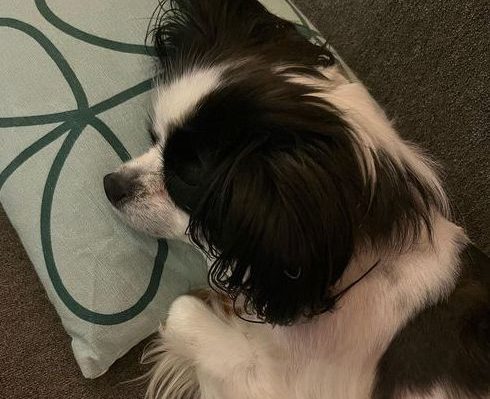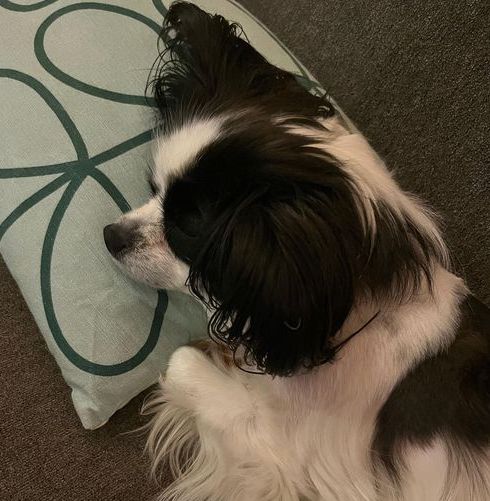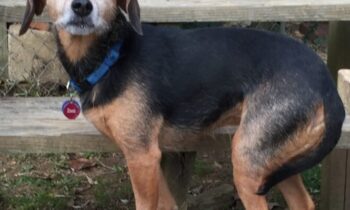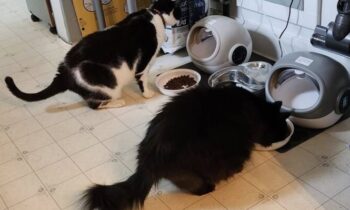

In early March, a friend’s little dog was attacked by a bigger dog. Last week, Alisha Ardiana detailed what happened. This week, she tells us about her dog’s resilience and recovery … and about what, as a trainer, she herself learned from the experience. Her insight and honesty are a gift to us all.
Question: You vowed, after the attack, to help your dog to learn to use the Bark Buddy potty set-up on your roof deck so she would not have to “go” in public on the street. How’s that working out?
Alisha Ardiana (California) I house-sat in a place with a yard for five days. I couldn’t believe how much quieter my nervous system was. We live in a very crowded neighborhood in San Francisco, with a large number of unstable people and unstable dogs. I often comment that I cannot guarantee that my dog will have a day free of fear and intimidation. By not walking in the neighborhood, she felt safe, I felt safe.
So I made it my goal to teach her to potty on our roof deck.
I began this process when she came to live with us three years ago, but she quickly decided she would rather pee in the neighborhood. It is very normal for her to pee at least three times on any given walk, and she will often pee ten times if we roam the neighborhood at night for an hour.
I decided on the product Bark Buddy. It was the right size, it’s compostable, and it’s shelf-stable. It arrived on the Thursday night following the attack. Despite all my best intentions, at that point my dog refused to use it.
Friday morning? She rejected it then as well, so I took her hiking.
I’m very fortunate that I have great dog friends. Two different friends came and picked up our new Bark Buddy potty and then returned it in the afternoon, used. One Bark potty was peed on by dogs my dog knew. One came from a dog daycare. When I walked into the house, I could see that my dog was very interested in both of these potty places. She was more than happy to sniff and pee on one.
As soon as she peed on the Bark Buddy, I instantly invited her to play a game. I feel very strongly that when we are asking our dogs to do big activities, we should follow up with big activities. Food is not enough. My dog’s favorite game to play is “Where is it?” That is when I hide her puzzle toys with food.
Ever since that Friday afternoon, March 10, she has been using the Bark Buddy potty at our home. I take her hiking once a day. Otherwise, she uses the Bark Buddy two to three times a day. No accidents. And we always play some kind of game afterwards.
That may seem like a lot, but let me tell you, not having to walk this dog? I will have a freaking parade for her every time. It’s worth it.

Photo by Alisha Ardiana
Question: Describe what her training had been up to the attack, and how that training helped her to deal with both the physical and the “emotional” aspects of the experience.
Alisha Ardiana: My specialty is helping dogs who struggle in San Francisco. We call them reactive dogs. When I decided to get a dog, I was adamant I would not get a reactive dog. I spent a great deal of time locating a breeder who bred for temperament. When the breeder offered me this ten-month-old dog, I made her take several videos in a variety of social situations so I could see that the dog was not reactive to dogs or people.
When my dog got to San Francisco, she was worried about the neighborhood, but she and I bonded very quickly. I took her hiking a lot; we began doing tricks training and getting to know each other. Unfortunately, when she was around age 13 months, we were ambushed on the steps of our house. We were walking out the door, a woman with two very reactive small dogs saw us. The small dogs barked and lunged. The woman dropped the leashes. The dogs came banging up the stairs, charging at us. I managed to save my dog from direct interaction, but that event was a huge trauma.
I have spent the last three years supporting my dog on our journey to feeling safe in San Francisco.
At first, I tried to give her social support, to tell her I would keep her safe and to help her move away. But an adolescent dog has huge safety concerns. I realized that I was telling her she was never going to work.
She needed to do something.
That is when we began to play games: “We see dogs, we play games, dogs go away.”
If she is concerned (and one is available), she will jump on a rock or a log to avoid another dog. That behavior gives her relief; it has replaced the behavior of barking.
It is critical for me to make sure that another dog does not come into her space. So I play bodyguard. That is a coping strategy developed by the trainer Kathy Sdao: “The trigger becomes the cue.”
We also began competing in NASDA, North American Sport Dog Association. The trials are typically held outside, and we have spent the last three years competing. The organization holds a variety of events, all focusing on dogs’ amazing sense of smell. My dog has learned how to hunt for a rat in a box. (The rats are pets, and they are safe.) She has learned how to locate and retrieve a deer antler. Her favorite activity is to look for lost items that belong to people. She can find our wallets, keys, and cell phones.
By going to these events, my dog has learned that other dogs are not her problem. She has learned to be neutral in most situations. And, most importantly, when she has concerns, she has learned to turn to me for help. If she is worried about an unknown dog, she will put her paws on my leg and ask me to pick her up.
It is amazing that she has developed a coping strategy that includes me, and it has given us huge access to public space. In the last year, we began hiking in off-leash dog areas that I never imagined we would visit. She has become incredibly confident and comfortable. And literally the week of the incident, we visited the most popular dog beach in San Francisco without any issue.
We joined NASDA because it was something to do with my dog that was accessible during COVID. Much to my surprise, we were invited to the national competition this June.
My dog is one of the top Papillons in the country. She will compete in four events. Two are rat hunting, in one she will look for a lost antler, in one she will look for lost items that belong to people. I’m truly astonished that something that we did for fun has been such a success. Added bonus? We are Facebook friends with the guardian of another top Papillon. We will share a house with them, and it will be a lot of fun. We both agree, may the best Papillon win. 🙂
Question: What did you learn from the attack that you hope dog guardians will understand and act on with their own dogs and others’ dogs?
Alisha Ardiana: It has been a journey, but I actually think that reactivity is a gift. It is a dog alerting me to a problem in the environment. Then it is my job to go into action. My dog and I excel at this. We are a team. Unfortunately, on the day of the attack, neither one of us recognized that the newcomer dog was a threat. Neither one of us anticipated or expected that resource-guarding event. The bigger dog’s guardians had no idea their dog could exhibit this behavior.
Consequently, I have changed my attitude about sharing space with large dogs. We have to start realizing that early life experiences can have a tremendous impact on dogs that may not appear until adolescence—the same way a child can be traumatized and go on to have a very difficult adulthood.
We have interacted with a huge variety of dogs of all shapes and sizes without issue.
But I now realize that an 80-pound dog can kill a 10-pound dog. Heck, a 35-pound dog could kill my dog.
Consequently, I am severely limiting her access to public space in the presence of unknown dogs. I had that attitude before this experience, and it will not be difficult to resume.
The reality is that she is ambivalent to other dogs. She’s not terribly dog-social, and I am her best friend. What matters to me is that we get to hike together and enjoy the world together. I never needed a dog-park dog, and even just going to the dog beach earlier this month was kind of a fluke. I’m actually happier when we are walking the beach alone without worrying about interruption.
I will no longer introduce my dog to client dogs. I will no longer take her on the group walk. I will be very careful about the dogs I introduce her to.
I nearly lost my dog. I feel awful that I made that mistake. I feel as if I’ve been blessed with the opportunity to share my life with her. I don’t ever want to put that at risk again.
Question: What advice do you have for all guardians of dogs?
Alisha Ardiana: “No” is a complete sentence. We need to let go of the idea that this is a Disney movie. The dogs don’t all have to meet each other. The dogs don’t need to interact with every dog that crosses their path. And when you are in public at an off-leash area, it does not mean you need to be available to the public.
I firmly held that boundary, which is necessary as a reactive-dog walker, but I definitely had loosened up my controls. I introduced my dog to client dogs, believing that I had a system where my dog could be safe. I was wrong.
No matter how hard we try, they are animals. They use their mouths to resolve conflict. And some dogs may never be predictable in the behaviors they express to get their needs met.
We don’t need to be paranoid, but we do need to be aware—the same way you need to be aware when you’re walking down the streets of San Francisco at night. Mistakes can happen. People and dogs can surprise us. The best we can do is to be cognizant and, most important, know how to repair the situation when things go sideways.
I’m so grateful that my dog continues to believe I’m safe. I actually think we are closer as a result of this incident. I will never forget the scream she let out when she was bitten. I will never forget the look on the guardian’s face when she saw what her dog did to my dog.
We love our dogs so much. We owe it to keep them safe, even if that sometimes means rejecting a potential contact in public. Brief interactions can be great, or they can be life-altering. We have to ask ourselves, is it worth it?
I am sharing the story of the attack in hopes that I will inspire others to stick up for their dogs. It is so difficult, with the public, not to succumb to social pressure. Your dog doesn’t need to meet every dog. Stand up for your dog. Don’t worry what the public thinks about you.
We asked our dogs to come live with us in this human-dominated world. We owe it to them to be their guides and to buffer them from the stressors.
Alisha Ardiana, BS, CTBC, CPDT-KA, FDM
empawthy ~ Positive reinforcement for pups & their people



